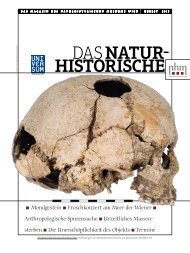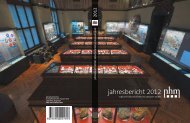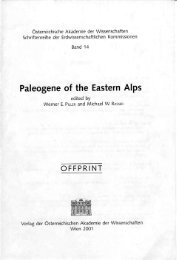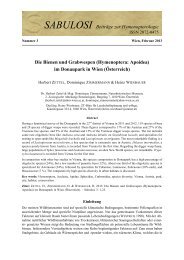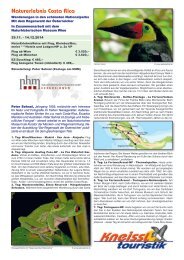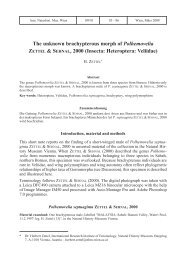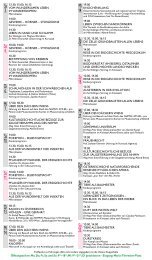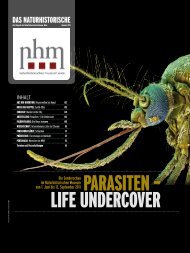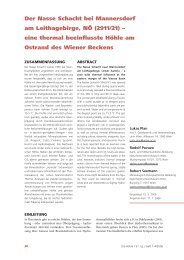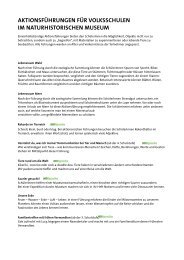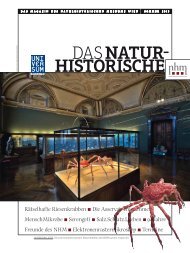Lukeneder pdf - Naturhistorisches Museum Wien
Lukeneder pdf - Naturhistorisches Museum Wien
Lukeneder pdf - Naturhistorisches Museum Wien
Create successful ePaper yourself
Turn your PDF publications into a flip-book with our unique Google optimized e-Paper software.
176<br />
177<br />
178<br />
179<br />
180<br />
181<br />
182<br />
183<br />
184<br />
185<br />
186<br />
187<br />
188<br />
189<br />
190<br />
191<br />
192<br />
193<br />
194<br />
195<br />
196<br />
197<br />
198<br />
199<br />
200<br />
201<br />
202<br />
203<br />
THE EARLY CRETACEOUS KARSTENICERAS LEVEL IN THE VIENNA WOODS 5<br />
�ig. 5. Ammonoid spectrum from the Sparbach locality. Note the dominance of the genus Karsteniceras (Ancyloceratina). Size distribution<br />
(below) of the species Karsteniceras ternbergense. Conventions: max. D. — shell diameter, max. B. — maximum breadth,<br />
WH — maximum whorl height, NW — umbilicus width, WB — whorl breadth.<br />
ations have been used (�ig. 5): max. D. — shell diameter;<br />
max. B. — maximum breadth; WH — maximum whorl<br />
height; NW — umbilicus width; WB — maximum whorl<br />
breadth; NHMW — <strong>Naturhistorisches</strong> <strong>Museum</strong> <strong>Wien</strong>. The<br />
author follows the classification of the Cretaceous Ammonoidea<br />
by Wright et al. (1996). Only specimens of the species<br />
Karsteniceras ternbergense, which are the dominant element<br />
of the fauna and the eponymous element of the<br />
investigated level, are described systematically herein. The<br />
measurements include only those from almost complete or<br />
well-preserved specimens.<br />
Article in Proof<br />
Order: Ammonoidea Zittel, 1884<br />
Suborder: Ancyloceratina Wiedmann, 1966<br />
Superfamily: Ancylocerataceae Gill, 1871<br />
�amily: Ancyloceratidae Gill, 1871<br />
Subfamily: Leptoceratoidinae Thieuloy, 1966<br />
Genus: Karsteniceras Royo y Gomez, 1945<br />
Type species: Ancyloceras beyrichi Karsten, 1858<br />
Karsteniceras ternbergense <strong>Lukeneder</strong> in <strong>Lukeneder</strong> et<br />
Tanabe, 2002<br />
�ig. 6.7–15<br />
2002 Karsteniceras ternbergense <strong>Lukeneder</strong> — <strong>Lukeneder</strong> et Tanabe,<br />
p. 18, �igs. 3A–C, 5–6<br />
2003b Karsteniceras ternbergense <strong>Lukeneder</strong> — <strong>Lukeneder</strong>, p. 96,<br />
Pl. 10, �igs. 1–13<br />
Material: 250 crushed and mainly limonitic specimens<br />
(sculpture moulds) from the locality near Sparbach, beds K1<br />
and K2 (�igs. 3 and 4). Most specimens are entire and show<br />
no fragmentation. Juvenile stages and the ventral area can be<br />
observed in a few specimens. The suture line is not visible.<br />
The whorl height (WH) varies from 2–7 mm, whereas the<br />
whorl breadth (WB) values are relatively constant from 0.6–<br />
2 mm due to compaction.<br />
Description: The small, criocone shells probably show<br />
weak torsions (trochospiral coiling). The spire becomes criocone<br />
after an advolute embryonal and juvenile stage. Some<br />
specimens become advolute in the middle of one whorl and revert<br />
to a criocone whorl later. A few specimens seem to be advolute<br />
over most of the whorl-distance. The species apparently<br />
has a highly variable coiling (<strong>Lukeneder</strong> 2003b). The sculpture<br />
comprises relative dense, sharp and simple ribs (<strong>Lukeneder</strong><br />
& Tanabe 2002; <strong>Lukeneder</strong> 2003b) intercepted by stronger<br />
main ribs on the body chambers (only visible in few specimens).<br />
The largest specimen reaches a diameter of 39 mm.<br />
Single, sharp, uniform ribs cross the venter without a ventral<br />
depression or furrow. Up to 45–50 single ribs are present on<br />
one whorl. No tubercles occur.<br />
Remarks: Karsteniceras ternbergense differs from all<br />
other descendant species of the genus Karsteniceras in its<br />
clear and distinct main ribs on the body chamber of adult specimens,<br />
different maximum size and number of ribs per whorl<br />
(<strong>Lukeneder</strong> & Tanabe 2002; <strong>Lukeneder</strong> 2003b). A detailed<br />
204<br />
205<br />
206<br />
207<br />
208<br />
209<br />
210<br />
211<br />
212<br />
213<br />
214<br />
215<br />
216<br />
217<br />
218<br />
219<br />
220<br />
221<br />
222<br />
223<br />
224<br />
225<br />
226<br />
227<br />
228<br />
229<br />
230



